Note: Yale School of the Environment (YSE) was formerly known as the Yale School of Forestry & Environmental Studies (F&ES). News articles and events posted prior to July 1, 2020 refer to the School's name at that time.
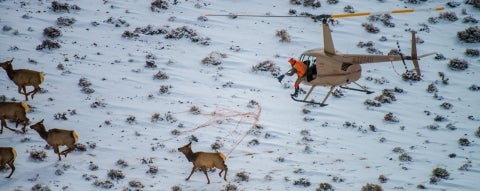 A helicopter capture crew nets a female elk to fit her with a GPS collar. Middleton and colleagues will map the Greater Yellowstone elk migrations comprehensively for the first time and the team has used this information to guide their expeditions. Photo: Joe Riis
A helicopter capture crew nets a female elk to fit her with a GPS collar. Middleton and colleagues will map the Greater Yellowstone elk migrations comprehensively for the first time and the team has used this information to guide their expeditions. Photo: Joe Riis
When you first meet ecologist Arthur Middleton ’07 M.E.M., “adventurer” isn’t necessarily the label that immediately comes to mind. He’s showing me a well-loved copy of geologist Ferdinand Vandeveer Hayden’s 1871 survey of what would become Yellowstone National Park the following year. In lieu of the ubiquitous Red Bull cap and sponsorship logos sported by most of today’s “adventurers,” Middleton – who has spent much of the past two years documenting elk migrations in the Greater Yellowstone Ecosystem (GYE) – wears a casual button-down shirt and tan pants. He is calm and even-toned, almost nostalgic, as he describes the animals and places he’s explored for the better part of the last decade. And he is disarmingly humble, a quality that makes his adventures all the more interesting to hear.
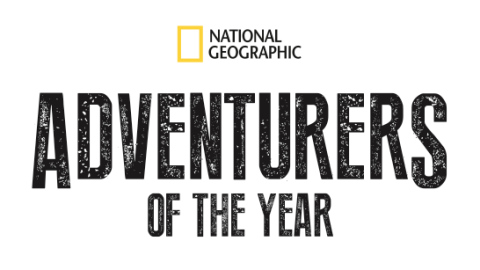
On Friday, National Geographic named Middleton, an Associate Research Scientist at the Yale School of Forestry & Environmental Studies, along with his teammate photographer Joe Riis, 2016 Adventurers of the Year. The award, which recognizes "remarkable achievement in exploration, adventure sports, conservation, and humanitarianism,” puts Middleton and Riis in an elite group with nine other adventurers. Now the public can vote everyday until January 31 for the team for the 2016 People's Choice Adventurer of the Year. Middleton says he was surprised to learn about the award.
“I didn’t have much awareness of the award because it’s something that usually goes to what we more conventionally think about adventurers – kayakers and mountain climbers and transatlantic voyagers,” he says. “So it wasn’t something that was in the center of my radar and that makes it very exciting. And it feels good for me, for what is largely a scientific endeavor – but an adventurous one – to make it into that circle and to be honored in that way.”
The award recognizes Middleton and Riis’s Greater Yellowstone Migrations (GYM) project. For the past two years, they have documented migrating elk from their winter range to their summer range high in Wyoming’s Absaroka Range. The Absarokas are home to the state’s second tallest mountain, Franc’s Peak, and nearly 50 other peaks over 12,000 feet. “It’s very rugged country. And sometimes the climbs and descents on these migration trails turn your stomach,” Middleton says. “But I always think, if a 500-pound cow elk can do this – can step on that rock or can cross that steep snowfield – I guess I should be able to do that.”
“I didn’t have much awareness of the award because it’s something that usually goes to what we more conventionally think about adventurers – kayakers and mountain climbers and transatlantic voyagers,” he says. “So it wasn’t something that was in the center of my radar and that makes it very exciting. And it feels good for me, for what is largely a scientific endeavor – but an adventurous one – to make it into that circle and to be honored in that way.”
The award recognizes Middleton and Riis’s Greater Yellowstone Migrations (GYM) project. For the past two years, they have documented migrating elk from their winter range to their summer range high in Wyoming’s Absaroka Range. The Absarokas are home to the state’s second tallest mountain, Franc’s Peak, and nearly 50 other peaks over 12,000 feet. “It’s very rugged country. And sometimes the climbs and descents on these migration trails turn your stomach,” Middleton says. “But I always think, if a 500-pound cow elk can do this – can step on that rock or can cross that steep snowfield – I guess I should be able to do that.”
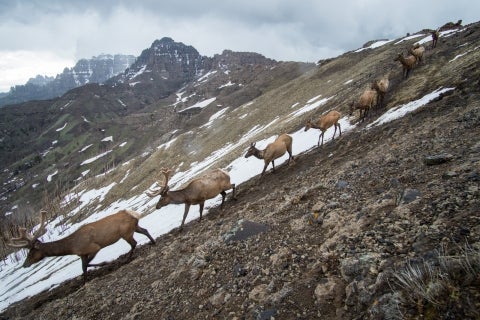 <div class="page" title="Page 1"> <div class="layoutArea"> <div class="column"> <p> Migrating elk crossing into the wilderness from the nearby ranches where they spend their winter. Thousands of migratory elk travel anywhere from 30 to 90 miles through incredibly rugged terrain to reach their summer ranges in and around Yellowstone National Park. Photo: Joe Riis</p> </div> </div></div>
<div class="page" title="Page 1"> <div class="layoutArea"> <div class="column"> <p> Migrating elk crossing into the wilderness from the nearby ranches where they spend their winter. Thousands of migratory elk travel anywhere from 30 to 90 miles through incredibly rugged terrain to reach their summer ranges in and around Yellowstone National Park. Photo: Joe Riis</p> </div> </div></div>
Middleton wasn’t always so focused on elk. After completing his masters at F&ES, Middleton attended the University of Wyoming for his PhD where he studied wolf-elk interactions in Sunlight Basin east of Yellowstone National Park. Originally he researched how wolves influence the decline of the Clark’s Fork elk herd in their winter range. Wolves play a huge role in the imagination of both scientists and the general public, Middleton says. But after years in the field, he began to realize that wolves didn’t have nearly as much to do with the decline of the herd as some other factors.
“Everybody looks at wolves and sees them as an agent of tremendous impact and change. And wolves have this aura of drama, Middleton says. “And, you know what? It turns out everybody’s blowing it out of proportion. They eat elk and they displace them in some ways, but those effects – there’s no way they could be as strong as what many ecologists and locals hypothesize that they are.”
Middleton turned his attention to the elks’ summer range high in the Absarokas and found that grizzly bears, whose numbers have grown in recent years, were eating most of the elk calves before the herd ever encountered wolves far below in Sunlight Basin. He also found that drought had a strong effect on elk pregnancy rates. “Sure, we found wolf effects [on the numbers of elk calves], they were just much smaller. The drought and the bears were depriving wolves of the opportunity to matter. In order to understand some of these populations, you have to understand what’s going on throughout the entirety of their year-round range,” he says.
But Yellowstone can be a daunting place for a young researcher. “This is a big, complex ecosystem and I came out of that work with a sense that these elk migrations are the way that I can start to understand this place,” Middleton says. He took a post-doctoral position at F&ES focusing on the migrations. But Middleton wasn’t only interested in how events deep in the wilderness like drought and grizzly predation were affecting animals that he saw out near a town like Cody, WY. He was also interested in how events occurring on the fringes of the ecosystem – such as agriculture or energy development – are transmitted back into its core.
“Whatever we’re doing, they’re taking the good and bad effects of it back into the core of one of our most beloved national parks. And it became sort of incredible to me that I couldn’t see a map of that phenomenon,” he says. “It became a quest for me to make it. And so I saw it as something that I could contribute to that place.”
“Everybody looks at wolves and sees them as an agent of tremendous impact and change. And wolves have this aura of drama, Middleton says. “And, you know what? It turns out everybody’s blowing it out of proportion. They eat elk and they displace them in some ways, but those effects – there’s no way they could be as strong as what many ecologists and locals hypothesize that they are.”
Middleton turned his attention to the elks’ summer range high in the Absarokas and found that grizzly bears, whose numbers have grown in recent years, were eating most of the elk calves before the herd ever encountered wolves far below in Sunlight Basin. He also found that drought had a strong effect on elk pregnancy rates. “Sure, we found wolf effects [on the numbers of elk calves], they were just much smaller. The drought and the bears were depriving wolves of the opportunity to matter. In order to understand some of these populations, you have to understand what’s going on throughout the entirety of their year-round range,” he says.
But Yellowstone can be a daunting place for a young researcher. “This is a big, complex ecosystem and I came out of that work with a sense that these elk migrations are the way that I can start to understand this place,” Middleton says. He took a post-doctoral position at F&ES focusing on the migrations. But Middleton wasn’t only interested in how events deep in the wilderness like drought and grizzly predation were affecting animals that he saw out near a town like Cody, WY. He was also interested in how events occurring on the fringes of the ecosystem – such as agriculture or energy development – are transmitted back into its core.
“Whatever we’re doing, they’re taking the good and bad effects of it back into the core of one of our most beloved national parks. And it became sort of incredible to me that I couldn’t see a map of that phenomenon,” he says. “It became a quest for me to make it. And so I saw it as something that I could contribute to that place.”
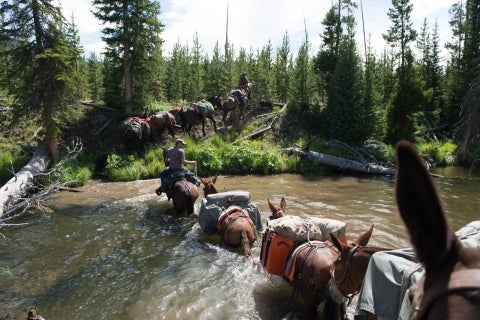 <p> Arthur Middleton and Wes Livingston cross a beaver pond in the Thorofare Valley during a 23-day pack trip to follow the migration of the Cody elk herd. Photo: Joe Riis</p>
<p> Arthur Middleton and Wes Livingston cross a beaver pond in the Thorofare Valley during a 23-day pack trip to follow the migration of the Cody elk herd. Photo: Joe Riis</p>
Despite many years of working in Yellowstone – and in other mountainous regions – Middleton found himself unprepared for the physical demands of crossing the Absarokas. When the he and Riis launched the project, they thought they could do the research on foot with backpacks. But they quickly realized they needed horses and mules to pack their gear and carry them deep into the backcountry.
He’s studying these animals and cares deeply about them, and wants to go beyond the journal article.
“Honestly, these mountains are more rugged, more difficult, harder to carry gear around in – just harder to penetrate – than any place I’d worked before,” he says.
Middleton and Riis also used GPS, geographic information systems (GIS), camera traps, and other technology to help tell the story of these migrations. With all of this technology, one might wonder why they felt it necessary to follow elk over challenging 12,000-foot mountain passes.
“It’s easy for people to imagine a scientist in a lab, or in a place like Yale Myers forest, looking through a microscope at a petri dish or working with a caged experimental system,” Middleton says. “Well, the GYE is my petri dish. And for me to look closely at what the critters are doing, I need to get in there. I need to put my boots on and walk, or get on a horse and pack in to the petri dish.”
“He’s putting himself out there because his ultimate goal is for his science and his conservation work to get in front of the general public,” Riis says. “He’s studying these animals and cares deeply about them, and wants to go beyond the journal article.”
Middleton and Riis also used GPS, geographic information systems (GIS), camera traps, and other technology to help tell the story of these migrations. With all of this technology, one might wonder why they felt it necessary to follow elk over challenging 12,000-foot mountain passes.
“It’s easy for people to imagine a scientist in a lab, or in a place like Yale Myers forest, looking through a microscope at a petri dish or working with a caged experimental system,” Middleton says. “Well, the GYE is my petri dish. And for me to look closely at what the critters are doing, I need to get in there. I need to put my boots on and walk, or get on a horse and pack in to the petri dish.”
“He’s putting himself out there because his ultimate goal is for his science and his conservation work to get in front of the general public,” Riis says. “He’s studying these animals and cares deeply about them, and wants to go beyond the journal article.”
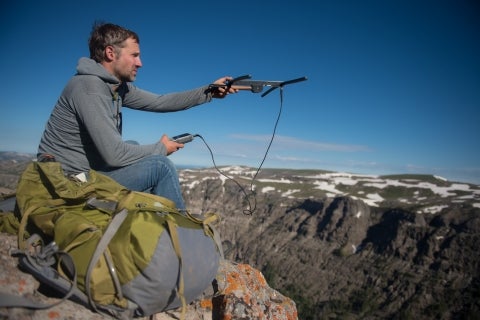 Arthur Middleton tracks a collared female elk high in the backcountry of the Absaroka Range. Photo: Joe Riis
Arthur Middleton tracks a collared female elk high in the backcountry of the Absaroka Range. Photo: Joe Riis
Riis, who grew up hunting in his home state of South Dakota and studied wildlife biology at the University of Wyoming, has no formal training in photography. He describes his work as “conservation photography” or “wildlife photojournalism” – showing wildlife and documenting their stories, but not excluding the human element. “There’s a tradition in wildlife photography where if an animal is crossing the road, you wait until it crosses the road and then you photograph it with the mountain in the backdrop,” Riis says. “And then there’s this other idea that you photograph it when it’s on the road. You essentially try to give the full picture to the story.”
After college, Riis was awarded a Young Explorers Grant by National Geographic and then spent two years photographing pronghorn in western Wyoming. “At the time, it was the longest documented land mammal migration in the lower 48,” Riis says, “but there were no pictures of it.” That project led to other assignments by National Geographic Magazine, taking him to South America and central Africa; photographing wild tigers in Thailand and Burma, and the elusive Gobi bear in Mongolia. But the GYM project was different.
For Riis, working with Middleton has been a dream come true. “It’s the type of long-form journalism project I want to do,” he says. “I want to do wildlife projects where I spend a year or two years or three years or maybe 10 years on one project and make pictures that people haven’t seen, that people won’t forget. And ultimately make a difference.”
About half of Riis’s work involves photographing the scientists and half is typically done with camera traps, photographing the animals that are being studied. Setting camera traps requires him to spend months in the backcountry figuring out where the elk are going, hiking the migration trails at different times of year, in different weather conditions, and under different light. “I’m trying to produce very unique pictures that are moments in these animals’ lives that can take months or years to make,” he says. “The purpose for me is to show people what it looks like to be a migrating animal, and to catch those moments when they’re at their most vulnerable.”
For Riis, working with Middleton has been a dream come true. “It’s the type of long-form journalism project I want to do,” he says. “I want to do wildlife projects where I spend a year or two years or three years or maybe 10 years on one project and make pictures that people haven’t seen, that people won’t forget. And ultimately make a difference.”
About half of Riis’s work involves photographing the scientists and half is typically done with camera traps, photographing the animals that are being studied. Setting camera traps requires him to spend months in the backcountry figuring out where the elk are going, hiking the migration trails at different times of year, in different weather conditions, and under different light. “I’m trying to produce very unique pictures that are moments in these animals’ lives that can take months or years to make,” he says. “The purpose for me is to show people what it looks like to be a migrating animal, and to catch those moments when they’re at their most vulnerable.”
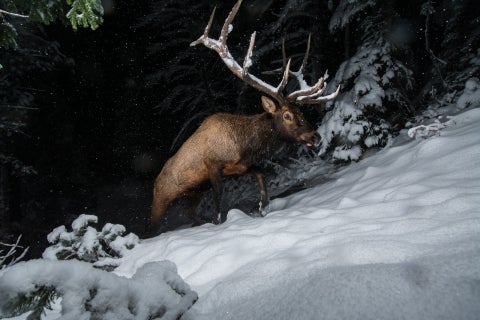 Bull Elk migrating from Yellowstone National Park to the lower-elevation foothills after the first snowfall in late October. Photo: Joe Riis
Bull Elk migrating from Yellowstone National Park to the lower-elevation foothills after the first snowfall in late October. Photo: Joe Riis
For both Middleton and Riis, storytelling is essential to conservation science. Originally funded by a grant from Prince Albert of Monaco, the GYM project now includes artwork by James Prosek and a film — Elk River — by Jenny Nichols. The project will be featured in the May 2016 issue of National Geographic Magazine.
Although National Geographic has been a pioneer in combining art, photography, and science, Riis says many scientists still shy away from working with a journalist, and that for scientists like Middleton, there’s a certain amount of professional risk involved. But he believes all scientists need to include storytelling. “We’re at the very beginning of this change in science,” he says. “The general public needs to know the results and the findings of scientists and the general public doesn’t typically read journal articles. So the scientists of the world have to go beyond the articles and they have to work with storytellers.”
Although National Geographic has been a pioneer in combining art, photography, and science, Riis says many scientists still shy away from working with a journalist, and that for scientists like Middleton, there’s a certain amount of professional risk involved. But he believes all scientists need to include storytelling. “We’re at the very beginning of this change in science,” he says. “The general public needs to know the results and the findings of scientists and the general public doesn’t typically read journal articles. So the scientists of the world have to go beyond the articles and they have to work with storytellers.”
It's a national treasure, this phenomenon.
For Middleton, the story of Yellowstone is a multifaceted one. In addition to geysers, waterfalls, and mountain vistas, Yellowstone is an ecological wonder – a system that lives and breathes and has some coherence as a larger landscape in which the park is embedded. And while abstractions such as “ecosystem” and “landscape” are necessary for scientists and agencies to communicate, Middleton knows there is a limit to the usefulness of such abstractions.
“We really ought not to expect that concept to make total sense to the general public without making a clear case for it,” Middleton says. “So our project has a lot to do with exploring that system through the eyes of some of the animals that transit back and forth, pulsing in and out of that landscape. The migrations are the best way of seeing that and showing it.”
“And it’s not an abstraction for those animals,” he continues. “They’re what all the predators eat. It’s not an abstraction to the people either. The elk are what the economy of a lot of small communities and businesses depend on. There are a lot of people with a stake in this thing who are focused on their jurisdiction, and elk, carnivores, fish, invasive species, climate effects are cutting across all of these jurisdictions. We don’t necessarily know what the answer is yet, but we think examining those questions through the eyes of one of those animals that has to navigate it is one way to start.”
But for Middleton, the elk migration is much more than just a subject of interest.
“I just think it’s an incredible thing to witness. It’s a national treasure, this phenomenon,” he says. “To me it’s like Old Faithful, [only] you just can’t go park in a parking lot and see it. But it’s something that has that kind of importance, I think, to that region and to our country. And it was there waiting to be explored.”
“We really ought not to expect that concept to make total sense to the general public without making a clear case for it,” Middleton says. “So our project has a lot to do with exploring that system through the eyes of some of the animals that transit back and forth, pulsing in and out of that landscape. The migrations are the best way of seeing that and showing it.”
“And it’s not an abstraction for those animals,” he continues. “They’re what all the predators eat. It’s not an abstraction to the people either. The elk are what the economy of a lot of small communities and businesses depend on. There are a lot of people with a stake in this thing who are focused on their jurisdiction, and elk, carnivores, fish, invasive species, climate effects are cutting across all of these jurisdictions. We don’t necessarily know what the answer is yet, but we think examining those questions through the eyes of one of those animals that has to navigate it is one way to start.”
But for Middleton, the elk migration is much more than just a subject of interest.
“I just think it’s an incredible thing to witness. It’s a national treasure, this phenomenon,” he says. “To me it’s like Old Faithful, [only] you just can’t go park in a parking lot and see it. But it’s something that has that kind of importance, I think, to that region and to our country. And it was there waiting to be explored.”
Published
November 19, 2015